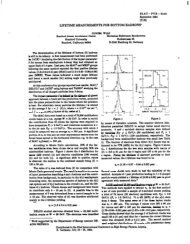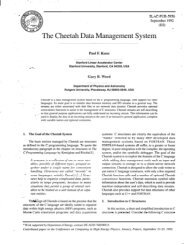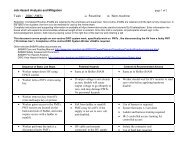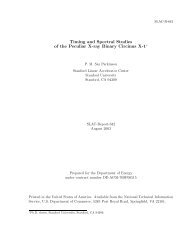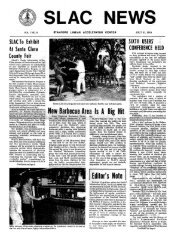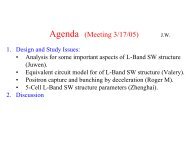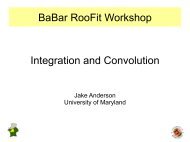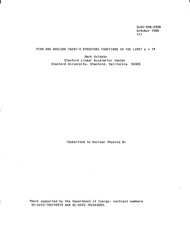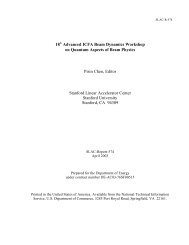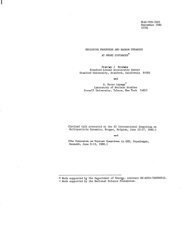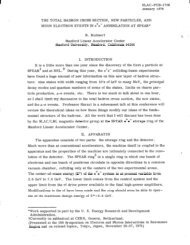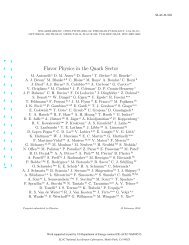The Use and Calibration of the Kern ME5000 Mekometer - SLAC ...
The Use and Calibration of the Kern ME5000 Mekometer - SLAC ...
The Use and Calibration of the Kern ME5000 Mekometer - SLAC ...
Create successful ePaper yourself
Turn your PDF publications into a flip-book with our unique Google optimized e-Paper software.
--<br />
Variance Component Analysis<br />
monuments are required. This scheme, shown in Figure 3, provides a lot <strong>of</strong> redundancy for<br />
<strong>the</strong> determination <strong>of</strong> <strong>the</strong> -addition constant <strong>and</strong> <strong>the</strong> variables describing <strong>the</strong> accuracy <strong>of</strong> <strong>the</strong><br />
instrument. <strong>The</strong> method <strong>of</strong> least squares adjustment is used to estimate <strong>the</strong>se values.<br />
FIGURE 2. Perfect Golomb ruler<br />
<strong>The</strong> approach used for <strong>the</strong> <strong>Mekometer</strong> calibrations does not require knowledge <strong>of</strong> <strong>the</strong><br />
absolute distances between monuments. Absolute distances are only necessary if a scale<br />
factor between two distance measurement devices is to be determined or <strong>the</strong> scale <strong>of</strong> <strong>the</strong><br />
instrument is in question or if <strong>the</strong> addition constant is assumed to be distance dependent.<br />
FIGURE 3. Distance measurements in all combinations<br />
For <strong>the</strong> alignment <strong>of</strong> <strong>the</strong> SLC two distance measurement devices were used; <strong>the</strong> <strong>Kern</strong><br />
DM503 for <strong>the</strong> measurement <strong>of</strong> <strong>the</strong> surface control network <strong>and</strong> <strong>the</strong> Distinvar for <strong>the</strong> tunnel<br />
control network. <strong>The</strong> baseline was <strong>the</strong>refore designed to allow Distinvar measurements over<br />
much <strong>of</strong> its length. A linear regression <strong>of</strong> corresponding distances for both devices is used to<br />
determine <strong>the</strong> scale factor between <strong>the</strong>se instruments. <strong>The</strong> measurements with <strong>the</strong> more<br />
accurate instrument, in this case <strong>the</strong> Distinvar, are assumed to be error free. An example<br />
output <strong>of</strong> this procedure is part <strong>of</strong> <strong>the</strong> appendix (item 3). It shows <strong>the</strong> differences between<br />
DM503 <strong>and</strong> Distinvar measurements plotted versus <strong>the</strong> Distinvar distances in meters using<br />
different symbols for each station. <strong>The</strong> results <strong>of</strong> <strong>the</strong> fit are shown in <strong>the</strong> upper right comer.<br />
<strong>The</strong> coefficient a represents <strong>the</strong> y-intercept <strong>and</strong> b <strong>the</strong> slope <strong>of</strong> <strong>the</strong> regression line. <strong>The</strong><br />
associate variances 0, <strong>and</strong> c$ are also displayed. <strong>The</strong> variable r represents <strong>the</strong> correlation<br />
coefficient between <strong>the</strong> DM503 <strong>and</strong> Distinvar distances <strong>and</strong> is a measure for <strong>the</strong> quality <strong>of</strong><br />
linearity. It can vary between +l <strong>and</strong> -1. In <strong>the</strong> case that all data points are on a straight line,<br />
r is +l. In <strong>the</strong> o<strong>the</strong>r extreme when no correlation between instruments exists, I is - 1. <strong>The</strong><br />
variable cr, represents <strong>the</strong> variance <strong>of</strong> <strong>the</strong> residuals.<br />
40<br />
a<br />
6



